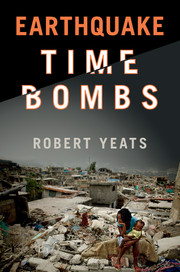Book contents
- Frontmatter
- Contents
- Acknowledgments
- Why this book?
- PART I EARTHQUAKES, DEEP TIME, AND THE POPULATION EXPLOSION
- PART II EARTHQUAKE TIME BOMBS
- TIME BOMBS WHERE THE PROBLEM IS UNDERSTOOD, BUT THE RESPONSE IS STILL INADEQUATE
- OTHER TIME BOMBS, INCLUDING CITIES THAT ARE NOT WELL PREPARED
- 13 Age of Enlightenment and the 1755 Lisbon earthquake
- 14 Jerusalem: earthquakes in the Holy Land
- 15 Istanbul: responding to an official earthquake warning
- 16 Tehran: the next earthquake in the Islamic Republic of Iran?
- 17 Kabul: decades of war and Babur's warning
- 18 Earthquakes in the Himalaya
- 19 Myanmar and the Sagaing fault
- 20 Metro Manila, the Philippines
- 21 Lima, Peru: Inca earthquake-resistant construction and a bogus American earthquake prediction
- 22 Andean earthquakes in Quito and Guayaquil, Ecuador
- 23 Caracas: lots of oil, but little interest in earthquakes
- 24 Haiti, which lost its gamble, and Jamaica and Cuba (not yet)
- 25 Mexico City: bowl of jello inherited from the Aztecs
- 26 Central America and the earthquake that brought down a dictator
- 27 East African Rift Valley: a tale of two cities
- PART III SUMMARY AND RECOMMENDATIONS
- References
- Index
20 - Metro Manila, the Philippines
from OTHER TIME BOMBS, INCLUDING CITIES THAT ARE NOT WELL PREPARED
Published online by Cambridge University Press: 05 November 2015
- Frontmatter
- Contents
- Acknowledgments
- Why this book?
- PART I EARTHQUAKES, DEEP TIME, AND THE POPULATION EXPLOSION
- PART II EARTHQUAKE TIME BOMBS
- TIME BOMBS WHERE THE PROBLEM IS UNDERSTOOD, BUT THE RESPONSE IS STILL INADEQUATE
- OTHER TIME BOMBS, INCLUDING CITIES THAT ARE NOT WELL PREPARED
- 13 Age of Enlightenment and the 1755 Lisbon earthquake
- 14 Jerusalem: earthquakes in the Holy Land
- 15 Istanbul: responding to an official earthquake warning
- 16 Tehran: the next earthquake in the Islamic Republic of Iran?
- 17 Kabul: decades of war and Babur's warning
- 18 Earthquakes in the Himalaya
- 19 Myanmar and the Sagaing fault
- 20 Metro Manila, the Philippines
- 21 Lima, Peru: Inca earthquake-resistant construction and a bogus American earthquake prediction
- 22 Andean earthquakes in Quito and Guayaquil, Ecuador
- 23 Caracas: lots of oil, but little interest in earthquakes
- 24 Haiti, which lost its gamble, and Jamaica and Cuba (not yet)
- 25 Mexico City: bowl of jello inherited from the Aztecs
- 26 Central America and the earthquake that brought down a dictator
- 27 East African Rift Valley: a tale of two cities
- PART III SUMMARY AND RECOMMENDATIONS
- References
- Index
Summary
A VIOLENT PATHWAY TO INDEPENDENCE
In the sixteenth century, Spain was a superpower. The King and Queen of León and Castile on the Iberian peninsula had sponsored Columbus’ discovery of the Western Hemisphere in four separate expeditions. These were followed by the first voyage around the world by Ferdinand Magellan in 1519–1522, sponsored by King Charles I of Spain, in search of the Spice Islands of present-day eastern Indonesia. The two largest empires in the Western Hemisphere were conquered: the Aztec empire of Mexico by Hernán Cortés in 1521 and the Inca empire of the central Andes of South America by Francisco Pizarro in 1532 (see Chapters 21 and 25 on Peru and Mexico). Both empires yielded vast treasures that were put on ships and sent to Spain. King Charles was later crowned as Charles V, Holy Roman Emperor, the most powerful monarch in Western Europe.
Magellan had claimed the Philippines for Spain during his expedition around the world. He had discovered islands southeast of the main island of Luzon, but he became involved in warfare among individual chieftains, and as a result he was killed in 1521. The rest of the expedition left the Philippines and returned to Europe, in the process completing Magellan's round-the-world voyage. Several expeditions followed, and on one of them the islands were named Islas Filipinas after King Philip of Spain. Philip ordered another expedition to the Spice Islands, southeast of the Philippines, although its real objective was the conquest of the Philippines. A trade route between the Philippines and Acapulco, Mexico and across the Caribbean and Atlantic Ocean to Spain (the Galleon Trade) was initiated, which continued for several centuries and brought great wealth to the Philippines and their colonial masters.
In 1570, a Spanish naval squadron conquered the Kingdom of Maynila, and in 1596, the Governor of the Philippines made Maynila, now renamed Manila, the capital. It has continued to be the capital to the present day. The Philippines were ruled by a Governor General, answering to the King of Spain. Most of the islanders were converted to Christianity except for the Muslim Moros of the southernmost islands west of Mindanao. The Philippines were under Spanish rule for the next three centuries, interrupted only by a brief occupation of Manila by the English in 1762–1764.
- Type
- Chapter
- Information
- Earthquake Time Bombs , pp. 243 - 250Publisher: Cambridge University PressPrint publication year: 2015



